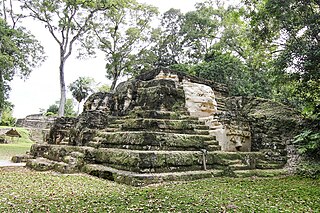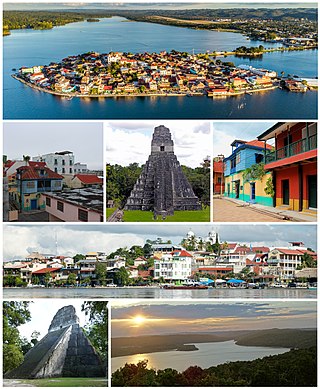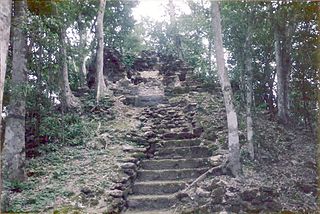
Richard D. Hansen is an American archaeologist who is an adjunct professor of anthropology at the University of Utah.

Richard D. Hansen is an American archaeologist who is an adjunct professor of anthropology at the University of Utah.
Hansen is a specialist on the ancient Maya civilization and directs the Mirador Basin Project, which investigates a circumscribed geological and cultural area known as the Mirador Basin in the northern Petén, Guatemala. [1] [2] He has previously held positions at the University of California, Los Angeles and Idaho State University.[ citation needed ] He is also the founder and president of the Foundation for Anthropological Research and Environmental Studies (FARES).[ citation needed ] His work has been featured in 36 film documentaries[ citation needed ] and was the principal consultant for the movie Apocalypto ,[ citation needed ] CBS' Survivor Guatemala ,[ citation needed ] and National Geographic's The Story of God with Morgan Freeman.[ citation needed ]
He was also awarded the Orden de la Monja Blanca by the Guatemalan Ministry of Defense in 2019. He was named as "one of the 24 individuals that changed Latin America" [3] and his work has been an important contribution to the understanding of the development of Maya civilization. [4]
Richard D. Hansen is a specialist on the early ancient Maya civilization and directs the Mirador Basin Project, which investigates a geological and cultural area known as the Mirador-Calakmul Karst Basin in the northern Petén, Guatemala. Archeological Research in the Petén, Guatemala Mirador Basin National Monument: The Cradle of Maya Civilization.
He is the founder and president of the Foundation for Anthropological Research and Environmental Studies (FARES), a non-profit scientific research institution based in Idaho.[ citation needed ]
He graduated with a Ph.D. in Archaeology from UCLA in 1992 as a National Graduate Fellow, a Jacob Javits National Fellow, the UCLA Hortense Fishbaugh Memorial Scholar, the UCLA Distinguished Scholar (1988), a Fulbright Scholar (Guatemala) (1989-1990), the UCLA Outstanding Graduate Student (1991), and the UCLA Chancellor's Marshall with highest honors (1992).
He previously held a double major B.S. degree (cum laude) in Spanish and Archaeology from Brigham Young University in 1978, and a M.S. degree in Anthropology in 1984.
He was recently named as "one of 24 individuals that changed Latin America" by Bravo Association, Latin Trade Magazine, Dec. He was awarded the highest civilian award possible in Guatemala, the Gran Cruz of the Order of Quetzal on March 9, 2017 in the National Palace of Guatemala by President Jimmy Morales and Minister Jose Luis Chea. He received the "Orden de la Monja Blanca) (highest civilian award possible) from the Ministry of Defense of Guatemala in November 2019. He was named the 2014 Kislak Lecturer at the U.S. Library of Congress, and was honored as the "Chevalier des Arts et des Lettres" of the "Ordre des Arts et Lettres" by the French Ministry of Culture in 2012. He was awarded the "Orden del Pop" by Francisco Marroquin University in Guatemala in 2012. He was awarded the highest Idaho State University Achievement Award 2009 and was named Environmentalist of the Year in Latin America 2008 by the 161,000 members of the Latin Trade Bravo Business Association. He was awarded the National Order of the Cultural Patrimony of Guatemala by Guatemalan President Oscar Berger in December 2005.
He was the founder of the Dialogue of Civilizations Conferences hosted by the National Geographic Society, with recent conferences in Guatemala, Turkey, and China and more scheduled for India and Egypt.[ citation needed ] Hansen was the co-founder of the Guatemala-China Association for Culture, Tourism and Sports based in Guatemala City.[ citation needed ]
He has published 3 books (2 as series editor), and is the editor of three more volumes currently in preparation. In addition, he has published 190 papers and book chapters in scientific and popular publications and has presented more than 393 professional papers and technical reports in scientific formats and symposia throughout the world. As a project, his team has currently published 318 scientific papers, abstracts, and book chapters, and 1209 technical reports and scientific presentations
He has conducted and/or directed archaeological research in Israel, the U.S. Great Basin, U.S. Southwest, and Central America. Hansen's research in the remote rainforests of northern Guatemala currently involves scholars from dozens of universities and research institutions from throughout the world.[ citation needed ]
His team has mapped and excavated in 51 ancient cities in the Mirador Basin.[ citation needed ] Hansen's studies have identified some of the largest and earliest ancient cities in Central America, and his work has been an important contribution to the developmental history of Maya civilization. [5] [ failed verification ]

Uaxactun is an ancient sacred place of the Maya civilization, located in the Petén Basin region of the Maya lowlands, in the present-day department of Petén, Guatemala. The site lies some 12 miles (19 km) north of the major center of Tikal. The name is sometimes spelled as Waxaktun.

Petén is a department of Guatemala. It is geographically the northernmost department of Guatemala, as well as the largest by area – at 35,854 km2 (13,843 sq mi) it accounts for about one third of Guatemala's area. The capital is Flores. The population at the mid-2018 official estimate was 595,548.

The Maya are an ethnolinguistic group of indigenous peoples of Mesoamerica. The ancient Maya civilization was formed by members of this group, and today's Maya are generally descended from people who lived within that historical region. Today they inhabit southern Mexico, Guatemala, Belize, and westernmost El Salvador and Honduras.

El Mirador is a large pre-Columbian Middle and Late Preclassic Maya settlement, located in the north of the modern department of El Petén, Guatemala. It is part of the Mirador-Calakmul Karst Basin of northern Guatemala.
Cival is an archaeological site in the Petén Basin region of the southern Maya lowlands, which was formerly a major city of the Pre-Columbian Maya civilization. It is located in the present-day Department of Petén, Guatemala.

A sacbe, plural sacbeob, or "white road", is a raised paved road built by the Maya civilization of pre-Columbian Mesoamerica. Most connect temples, plazas, and groups of structures within ceremonial centers or cities, but some longer roads between cities are also known. The term "sacbe" is Yucatec Maya for "white road"; white perhaps because there is evidence that they were originally coated with limestone stucco or plaster, which was over a stone and rubble fill. Although great progress has been made on determining the roles of sacbeob in Maya society, the decision to construct sacbeob as opposed to smaller, less complicated paths is puzzling to experts. Without a profound reliance on beasts of burden to transport goods, it remains partially unclear why the Maya decided to expend so much labor constructing these impressive roads. However it remains a very plausible theory that the Sacbe held significant spiritual and religious value, in the sense that the actual trekking of the Sacbe itself seemed to be a spiritual journey of sorts.

Apocalypto is a 2006 epic historical action-adventure film produced and directed by Mel Gibson, who co-wrote the screenplay with Farhad Safinia. The film features a cast of Indigenous and Mexican actors consisting of Rudy Youngblood, Raoul Trujillo, Mayra Sérbulo, Dalia Hernández, Gerardo Taracena, Jonathan Brewer, Rodolfo Palacios, Bernardo Ruiz Juarez, Ammel Rodrigo Mendoza, Ricardo Diaz Mendoza, and Israel Contreras. Set in Yucatán around the year 1517, Apocalypto portrays the hero's journey of a young man named Jaguar Paw, a late Mesoamerican hunter and his fellow tribesmen who are captured by an invading force. After the devastation of their village, they are brought on a perilous journey to a Maya city for human sacrifice at a time when the Maya civilization is in decline.
Naachtun is an archaeological site of the pre-Columbian Maya civilization, situated at the northeastern perimeter of the Mirador Basin region in the southern Maya lowlands, now in the modern-day Department of El Petén, northern Guatemala. Naachtun was a major center of the region by the late Formative Period, and was one of the few Formative Period Mirador Basin centers which continued to flourish into the succeeding Classic period.

Nakbe is one of the largest early Maya archaeological sites. Nakbe is located in the Mirador Basin, in the Petén region of Guatemala, approximately 13 kilometers south of the largest Maya city of El Mirador. Excavations at Nakbe suggest that habitation began at the site during the Early Formative period and continued to be a large site until its collapse during the Terminal Formative period. The fall of Nakbe and El Mirador took place at roughly the same time.
Arthur Andrew Demarest is an American anthropologist and archaeologist, known for his studies of the Maya civilization.

The Maya Biosphere Reserve is a nature reserve in Guatemala managed by Guatemala's National Council of Protected Areas (CONAP). The Maya Biosphere Reserve covers an area of 21,602 km2, one-fifth of the country's total land area.
The Petén Basin is a geographical subregion of the Maya Lowlands, primarily located in northern Guatemala within the Department of El Petén, and into the state of Campeche in southeastern Mexico.
Pajaral, otherwise known as El Pajaral, is the modern name for a mid-sized ruined city of the pre-Columbian Maya archaeological site located to the south of the San Pedro Martir river in the Petén department of Guatemala. The name El Pajaral was coined by archaeologist Ian Graham, who discovered the site in the 1970s, and refers to the numerous birds he encountered there during his survey.

The Mirador Basin is a hypothesized geological depression found in the remote rainforest of the northern department of Petén, Guatemala. Mirador Basin consists of two true basins, consisting of shallowly sloping terrain dominated by low-lying swamps called bajos; one draining into the San Pedro River and the other into the Candelaria River. The basin is surrounded by rugged karstic limestone hills on the east and south, forming a triangular geographical "trough" covering more than 2,169 km2 (837 sq mi). The geological formation of the landscape, as well as the significance of the formation, are the subject of some controversy in Northern Guatemala. NASA Shuttle Radar Topography Mission (SRTM) data indicate no depression in the area.
The Southern Maya Area is a region of Pre-Columbian sites in Mesoamerica. It is long believed important to the rise of Maya civilization, during the period that is known as Preclassic. It lies within a broad arc going southeast from Chiapa de Corzo in Mexico to Copán and Chalchuapa, in Central America.
William Andrew "Bill" Saturno is an American archaeologist and Mayanist scholar who has made significant contributions toward the study of the pre-Columbian Maya civilization. Saturno is a former director of the Proyecto San Bartolo-Xultun at the Instito de Antropologia e Historia in Guatemala, a former national space research scientist at the Marshall Space Flight Center, and a research associate at the Peabody Museum at Harvard University. Saturno has previously worked as an Assistant Professor of Archaeology at Boston University and MIT and as a lecturer at the University of New Hampshire.

El Tintal is a Maya archaeological site in the northern Petén region of Guatemala, about 25 kilometres (16 mi) northeast of the modern-day settlement of Carmelita, with settlement dating to the Preclassic and Classic periods. It is close to the better known sites of El Mirador, to which it was linked by causeway, and Nakbé. El Tintal is a sizeable site that includes some very large structures and it is one of the four largest sites in the northern Petén; it is the second largest site in the Mirador Basin, after El Mirador itself. El Tintal features monumental architecture dating to the Middle Preclassic similar to that found at El Mirador, Nakbé and Wakna. Potsherds recovered from the site date to the Late Preclassic and Early Classic periods, and construction continued at the site in the Late Classic period.

Triadic pyramids were an innovation of the Preclassic Maya civilization consisting of a dominant structure flanked by two smaller inward-facing buildings, all mounted upon a single basal platform. The largest known triadic pyramid was built at El Mirador in the Petén Basin of Guatemala; it covers an area six times as large as that covered by Tikal Temple IV, which is the largest pyramid at that city. The three superstructures all have stairways leading up from the central plaza on top of the basal platform. Triadic pyramid structures are found at early cities in the Maya lowlands.

Maya cities were the centres of population of the pre-Columbian Maya civilization of Mesoamerica. They served the specialised roles of administration, commerce, manufacturing and religion that characterised ancient cities worldwide. Maya cities tended to be more dispersed than cities in other societies, even within Mesoamerica, as a result of adaptation to a lowland tropical environment that allowed food production amidst areas dedicated to other activities. They lacked the grid plans of the highland cities of central Mexico, such as Teotihuacán and Tenochtitlan. Maya kings ruled their kingdoms from palaces that were situated within the centre of their cities. Cities tended to be located in places that controlled trade routes or that could supply essential products. This allowed the elites that controlled trade to increase their wealth and status. Such cities were able to construct temples for public ceremonies, thus attracting further inhabitants to the city. Those cities that had favourable conditions for food production, combined with access to trade routes, were likely to develop into the capital cities of early Maya states.
The history of Maya civilization is divided into three principal periods: the Preclassic, Classic and Postclassic periods; these were preceded by the Archaic Period, which saw the first settled villages and early developments in agriculture. Modern scholars regard these periods as arbitrary divisions of chronology of the Maya civilization, rather than indicative of cultural evolution or decadence. Definitions of the start and end dates of period spans can vary by as much as a century, depending on the author. The Preclassic lasted from approximately 3000 BC to approximately 250 AD; this was followed by the Classic, from 250 AD to roughly 950 AD, then by the Postclassic, from 950 AD to the middle of the 16th century. Each period is further subdivided: